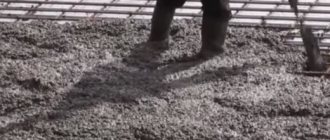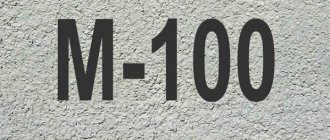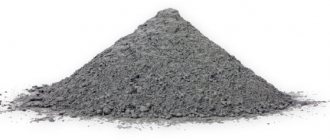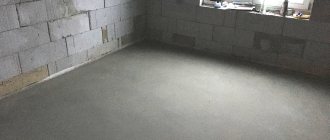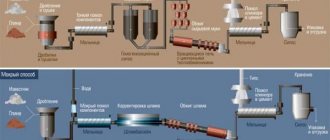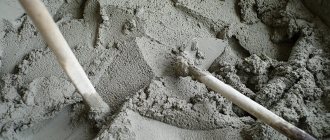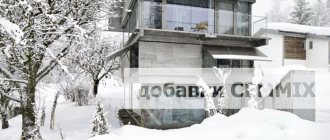Construction structural material – concrete M300, is the most popular type of heavy concrete. Concrete of this brand has optimal technical characteristics both for the manufacture of concrete products (paving slabs, paving stones, curbs, etc.) and for low-rise and high-rise construction of buildings and general purpose structures.
In particular, concrete grade M300 is widely used in the following types of construction work:
- Construction of monolithic load-bearing walls.
- Construction of different types of foundations: strip, slab and pile-grillage.
- Manufacturing of staircases, columns, floor slabs and concrete fences.
- Laying roads and concrete pavements for other purposes.
Where can you find this building material B 22.5?
Liquid concrete of class B22.5 is used for the construction of high and low-rise buildings, reinforced concrete monolithic structures, and reinforced concrete products. Quality, long service life, price - these are the three main advantages.
With a mortar with a strength of 295 kgf/cm², the following problems are solved in monolithic construction:
- construction of foundations, piles, supports for the construction of various types of houses;
- reinforced concrete buildings on private plots;
- interfloor ceilings;
- monolithic walls, structures;
- construction of drains and wells;
- fences, curbs, sidewalks.
Order a concrete mixture of heavy compressive strength class B22.5 BST from the manufacturing plant in Moscow without resellers’ markup by phone: +7 (495) 128-83-80
Independent preparation of concrete M300
Concrete of this type and this brand can be made at home. In this case, the developer saves significantly on costs. Judge for yourself, here is an approximate calculation of the cost of manufacturing 1 m3 of M300 concrete:
- M400 cement in 335 kg bags, with an average price of 285 rubles per 50 kg bag: 335/50x285=1909 rubles.
- Crushed stone 1105 kg, with an average price of 600 rubles. for 1,000 kg: 1.105x600=663 rub.
- Sand 670 kg with an average price of 400 rubles. for 1,000 kg: 400x670=240 rub.
Total: 1909+663+240=2812 rubles per 1 m3 of M300 concrete, excluding the cost of water and electricity for mixing the components in a concrete mixer. As you can see, depending on the region of Russia, it makes sense or not to prepare M300 concrete on your own, or it is better to order ready-made GOST material at the nearest concrete plant, if there is one within transport accessibility from the construction site.
Technical indicators of ready-mix concrete mixture B22.5 on gravel
Main technical indicators of class BB22 5:
- Strength – 295 kgf/cm², 28.9 MPa;
- Density - 1600-1900 kg/m³;
- Frost resistance – F150-F200;
- Water resistance – W8-W10;
- Mobility indicator – P4;
- Weight of 1m³ - 1850-2500 kg (depending on the type of crushed stone).
Order concrete (BST, BSL) from the manufacturer with strength class B22.5 according to standard indicators or improved through the use of additives. Additives improve performance and allow work to be done at sub-zero temperatures.
Concrete M300: main technical characteristics
- Concrete class M300: B22.5-B25. This characteristic characterizes the compressive strength of hardened concrete and varies from 28 MPa (280 kgf/cm2) to 32 MPa (320 kgf/cm2). The specific strength of concrete depends on the coefficient of variation of a particular mixture, which in turn depends on the homogeneity of the components and the amount of impurities (soil, clay). For example, with a coefficient of variation of 5%, concrete M300 corresponds to class B25, and with a coefficient of variation of 13.5% - class B22.5.
- The specific gravity of 1 m3 of M300 concrete varies from 1,800 to 2,500 kg/m3. This technical characteristic is also called the density of concrete M300, and depends on the type of heavy filler (crushed stone) and the amount of cavities and air bubbles in the thickness of the material. When crushed limestone is used as a heavy filler, concrete has a minimum specific gravity, and when granite crushed stone is used, it has a maximum specific gravity. A decrease in the weight of M300 concrete below 1,800 kg/m3 indicates a violation of the material manufacturing technology.
- Frost resistance: F150-F The numerical value indicates the guaranteed number of freeze-thaw cycles that a structure made of M300 concrete will withstand. The building material, prepared using traditional technology, has a frost resistance of 150 freeze-thaw cycles. To increase frost resistance, special additives are introduced into concrete, vibration is performed, the optimal “Cement-Water” ratio is used, and only granite crushed stone is used as a filler.
- Water permeability W5-W The numerical value indicates the amount of excess water pressure that a 15-centimeter wall made of M300t concrete can withstand - from 5 to 6 kgf/cm2. Increasing water resistance is possible through the use of special additives, the use of hydrophobic cement and increasing the density of concrete by vibration.
- Workability or mobility. Refers to the characteristics of M300 concrete, which depends on the type of equipment used to pour the structure. For example, concrete supplied to the formwork by concrete pumps should have a mobility from P4 to P5. The required amount of mobility is achieved by adding a plasticizer using a certain aodo-cement ratio.
- Price. There are two ways to obtain M300 concrete: buy ready-made material at a concrete plant or mix it yourself. Do-it-yourself production is advisable with a small daily consumption of concrete. In all other cases, it is best to purchase Gostov concrete M300 at a concrete plant. At the time of writing this article, the cost of concrete of this brand ranges from 3,900 to 4,500 rubles per 1 m3 without delivery costs. Delivery is paid separately, depending on the volume of delivery and delivery distance. The price of the material depends on the region, type and brand of filler and the presence of special additives.
Proportions for preparing 1 m³ of concrete B 22.5 at a concrete plant in Moscow
Such high reliability and strength indicators are obtained by adding the following components per 1 m³ of gravel mixture:
- Cement grade 400, 500 – 382 kg;
- Purified water with pH 4-12.5 – 220 l.;
- Filler (crushed stone, gravel, limestone) – 1.08 tons;
- Sand without foreign impurities (2-2.5 sizes) – 705 kg.
Expanded clay concrete is no less durable concrete mixture, but with excellent thermal insulation properties combined with the low weight of 1 cubic meter of solution. It is used where it is necessary to reduce the weight of a monolithic structure, therefore it belongs to the BSL lightweight concrete mixtures. The roof, monolithic foundation and walls are poured.
The solution does not contain harmful impurities that can harm the human body, so it can be used without restrictions.
Composition of concrete M300
The classic set of components for the production of heavy concrete of any brand includes the following materials:
- Portland cement. At the same time, in accordance with the requirements of SNiP 5.01.23-83, Portland cement grade TsEM I 32.5N PTs (M400) or grade TsEM I 42.5N PTs (M500) can be used for the preparation of building materials. Depending on the “percentage” of the concrete’s tempering strength (natural strength, strength of 70% or less, design strength from 80 to 100%), this Normative Document identifies M400 or M500 cement as “recommended” or “permissible.”
- Crushed stone. It is allowed to use granite, limestone and gravel filler. Depending on the type of crushed stone, concrete class M300 B22.5 or B25 is obtained.
- Sand. It is allowed to use a quarry, river or expanded clay product.
- Water. In accordance with the requirements of GOST 23732-2011, water for concrete production should not contain chemical impurities that can affect the setting of cement, hardening speed, strength, frost resistance and water resistance of the material. It is not allowed to use sewage, swamp and peat water.
To increase frost resistance, workability, waterproofness and frost resistance, as well as to make construction possible in conditions of negative ambient temperatures, special additives and a plasticizer are introduced into the concrete composition.
Proportions and composition of concrete m300 table for preparing 1 m3 of material
| Cement brand | Number of parts of cement/cement consumption in kg per 1 m3 of concrete | Number of parts of crushed stone/consumption of crushed stone in kg per 1 m3 of concrete | Number of parts of sand/sand consumption in kg per 1 m3 of concrete | Number of parts of water/water consumption in liters per 1 m3 of concrete |
| TsEM I 32.5N PC (M400) | 1/335 | 3,3/1105 | 2/670 | 0,6/190 |
| TsEM I 42.5N PC (M500) | 1/325 | 3,5/1105 | 1,8/580 | 0,7/230 |
The proportions of 1 cube of M300 concrete presented in the table may differ slightly up or down depending on the accuracy of the calculations adopted in accordance with certain regulatory documents.
Areas and features of application
Concrete grade M300 is often used for:
- construction of transport interchanges, sidewalks and high-traffic paths;
- construction of walls and supports of houses;
- arrangement of stairs (flights and steps);
- strengthening fences;
- pouring reinforced concrete structures;
- concreting sewer drains.
Concrete grade M300 is needed for the construction of buildings that will be subject to heavy loads. It is valued for its strength, waterproofness and rigidity.
Concrete B22.5 (concrete M300): scope
The mixture belongs to class B22.5; in construction it is used for the construction of such objects as:
- structures for various purposes;
- road surface, curbs or sidewalks;
- fences;
- monolithic concrete foundation for buildings of various sizes and heights;
- staircase steps and landings;
- sewer systems.
Concrete grade B22.5 (M300) is suitable for pouring paving slabs and producing reinforced concrete products.
Technical characteristics of the mixture B22.5 (M300)
The characteristics of a given brand of concrete depend on the ingredients included. The finished product has the following properties:
| Index | Values |
| Density | 2350-2400 kg/cub.m |
| Mobility | P2 - P4 |
| Rigidity | Zh2 - Zh4 |
| Frost resistance | F150 |
| Waterproof | W6 |
The specific gravity of a cube of M300 concrete is from 1 t 800 kg to 2 t 500 kg. The lowest indicator is observed when limestone is added to the composition, the highest when crushed stone from hard rock is added. produces a high-quality mixture that belongs to the heavy types. The finished product is characterized by a low level of moisture absorption, maintaining all properties with a large number of freezing and thawing cycles.
Our company works with granite crushed stone, which gives the solution special strength. As a result, the risk of deformation of finished structures is reduced to zero. Concrete M300 is produced from thoroughly washed sand with particle size modules of 2.5 mm and above.
In addition to these three components, plasticizers, various additives to improve technical performance, and water purified from impurities are used. The volume of liquid is calculated individually in each case; this indicator depends on the quality of the raw materials and weather conditions at the time of working with the solution.
Prices and ordering concrete B22.5 (M300)
At Ecobeton LLC, the final cost of M300 concrete depends on several factors. When drawing up an estimate, the brand of the original cement, the qualitative composition of the additives added, and the time of year when the purchase was made are taken into account. Prices for concrete B22.5 (M300) increase if there is a significant distance to the site and special equipment rented from the company’s fleet is used.
Our products comply with GOST regulations and a recipe specially developed for these purposes. The corresponding certificates are confirmation of high quality.
Features of manufacturing M300
To achieve certain characteristics according to standards, the manufacturer constantly measures the quality of the manufactured material. Therefore, M300, in its consistency and ductility, as well as the operational properties of hardened reinforced concrete elements and structures, fully complies with GOST.
Technologists can change the composition of the concrete solution at the customer’s request. The adjustments concern the following points:
- Adding frost-resistant additives;
- Changes in concrete plasticity category;
- Introduction of accelerators for binding mixture particles into the concrete fraction.
Note: At the same time, the standard proportions for the M300 are strictly observed according to the prescribed standards.
Features of concrete mix marking
According to GOST 25192-2012, the fundamental parameters of concrete are:
- Brand
– displayed by the letter M and determines the strength of the created surface. Strength grades of concrete make it possible to find out what pressure in kilogram-force a frozen solution can withstand for each square centimeter of area (kgf/cm2). - Class
- helps to evaluate the compressive strength of a building material. This indicator is displayed as the letter B with numbers that indicate the pressure withstood by the frozen mixture in MPa. - Density
is considered as the ratio of the weight of a material to the volume it occupies. Based on this parameter, a distinction is made between extra-light concrete (up to D800), light (D800–D2000), heavy (D2000–D2500) and extra-heavy (over D2500). All of them are designed for different types of work and differ in the type of aggregates used. - Frost resistance
- allows you to determine how many freezing/thawing cycles concrete can withstand while maintaining its original strength. According to this criterion, brands from F50 to F500 are distinguished. - Mobility
– determines the convenience of laying concrete mortar. When carrying out standard monolithic construction, types of concrete such as P2 and P3 are used. If hard-to-reach areas and small cavities are being filled, buy building material P4 and higher. - Water resistance
- indicates the ability of a building material not to allow moisture to pass through under pressure. The parameter is indicated as the letter W and varies from 2 to 20.
Application area
As can be seen from the technical characteristics, M300 B22.5 concrete has high strength, water resistance, and tolerates frost well. All this determined the area of its use. It is used:
- When pouring the foundations of private houses and cottages.
- For a blind area around the house.
- For garden paths, making homemade slabs for paths.
Concrete M300 B22.5 is widely used in both private and multi-storey construction
- In the manufacture of concrete stairs.
- For concreting a platform for a car.
- For monolithic walls and ceilings in multi-storey buildings.
- During the construction of a swimming pool.
As you can see, M300 B22.5 concrete is also used in frequent housing construction. It is especially popular when pouring a foundation, but for this purpose it is better to order a ready-made solution. Especially when pouring a slab foundation. Then you will definitely be able to fill the entire area without cold seams. In other cases, the volumes will not be so significant and you can prepare M300 concrete with your own hands.
